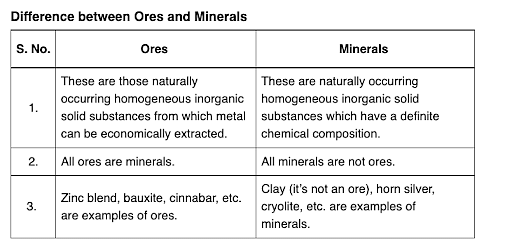Which one of the following reactions does not occur during extraction of copper?
- $CaO + SiO _2 \rightarrow CaSiO _3$
- $2 Cu _2 S +3 O _2 \rightarrow 2 Cu _2 O +2 SO _2$
- $FeO + SiO _2 \rightarrow FeSiO _3$
- $2 FeS +3 O _2 \rightarrow 2 FeO +2 SO _2$
The Correct Option is A
Solution and Explanation
No formation of calcium silicate in extraction of .
So, the correct option is (A): $CaO + SiO _2 \rightarrow CaSiO _3$
Top Questions on Thermodynamics terms
- A Carnot engine (E) is working between two temperatures 473K and 273K. In a new system two engines - engine \(E_1\) works between 473K to 373K and engine \(E_2\) works between 373K to 273K. If \(\eta_{12}\), \(\eta_1\) and \(\eta_2\) are the efficiencies of the engines \(E\), \(E_1\) and \(E_2\), respectively, then:
- JEE Main - 2025
- Physics
- Thermodynamics terms
- A Carnot engine (E) is working between two temperatures 473K and 273K. In a new system two engines - engine \(E_1\) works between 473K to 373K and engine \(E_2\) works between 373K to 273K. If \(\eta_{12}\), \(\eta_1\) and \(\eta_2\) are the efficiencies of the engines \(E\), \(E_1\) and \(E_2\), respectively, then:
- JEE Main - 2025
- Physics
- Thermodynamics terms
- Which of the following figure represents the relation between Celsius and Fahrenheit temperatures?
- JEE Main - 2025
- Physics
- Thermodynamics terms
- Which of the following figure represents the relation between Celsius and Fahrenheit temperatures?
- JEE Main - 2025
- Physics
- Thermodynamics terms
- Given below are two statements: one is labelled as Assertion A and the other is labelled as Reason R. Assertion A: In a central force field, the work done is independent of the path chosen. Reason R: Every force encountered in mechanics does not have an associated potential energy. In the light of the above statements, choose the most appropriate answer from the options given below.
- JEE Main - 2025
- Physics
- Thermodynamics terms
Questions Asked in JEE Main exam
The magnitude of heat exchanged by a system for the given cyclic process ABC (as shown in the figure) is (in SI units):

- JEE Main - 2025
- Electric charges and fields
- The value of \( (\sin 70^\circ)(\cot 10^\circ \cot 70^\circ - 1) \) is:
- JEE Main - 2025
- Trigonometric Identities
- The number of 6-letter words, with or without meaning, that can be formed using the letters of the word "MATHS" such that any letter that appears in the word must appear at least twice is:
- JEE Main - 2025
- Calculus
- 10 mL of 2 M NaOH solution is added to 20 mL of 1 M HCl solution kept in a beaker. Now, 10 mL of this mixture is poured into a volumetric flask of 100 mL containing 2 moles of HCl and made the volume upto the mark with distilled water. The solution in this flask is :
- JEE Main - 2025
- Solutions
Consider the following sequence of reactions :

Molar mass of the product formed (A) is ______ g mol\(^{-1}\).- JEE Main - 2025
- Organic Chemistry
Concepts Used:
General Principles and Processes of Isolation of Elements
What are Ores and Minerals?
Minerals are the naturally occurring, homogeneous inorganic solid substances. They are having a definite chemical composition and crystalline structure, hardness and color. For example, copper pyrite, calamine, etc.

Impurities in an ore are called gauge. The removal of a gauge from the ore is called concentration ore.
Several steps are involved in the extraction of pure metal from ores. Major steps are as follows –
- Concentration of the ore
- Isolation of the metal from its concentrated ore
- Purification of the metal